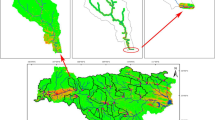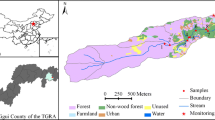Abstract
Land use has obvious influence on surface water quality; thus, it is important to understand the effects of land use patterns on surface water quality. This study explored the relationships between land use patterns and stream nutrient levels, including ammonium-N (NH4 +-N), nitrate-N (NO3 −-N), total N (TN), dissolved P (DP), and total P (TP) concentrations, in one forest and 12 agricultural catchments in subtropical central China. The results indicated that the TN concentrations ranged between 0.90 and 6.50 mg L−1 and the TP concentrations ranged between 0.08 and 0.53 mg L−1, showing that moderate nutrient pollution occurred in the catchments. The proportional areal coverages of forests, paddy fields, tea fields, residential areas, and water had distinct effects on stream nutrient levels. Except for the forest, all studied land use types had a potential to increase stream nutrient levels in the catchments. The land use pattern indices at the landscape level were significantly correlated to N nutrients but rarely correlated to P nutrients in stream water, whereas the influence of the land use pattern indices at the class level on stream water quality differentiated among the land use types and nutrient species. Multiple regression analysis suggested that land use pattern indices at the class level, including patch density (PD), largest patch index (LPI), mean shape index (SHMN), and mean Euclidian nearest neighbor distance (ENNMN), played an intrinsic role in influencing stream nutrient quality, and these four indices explained 35.08 % of the variability of stream nutrient levels in the catchments (p<0.001). Therefore, this research provides useful ideas and insights for land use planners and managers interested in controlling stream nutrient pollution in subtropical central China.


Similar content being viewed by others
References
Alberti M, Booth D, Hill K, Coburn B, Avolio C, Coe S, Spirandelli D (2007) The impact of urban patterns on aquatic ecosystems: an empirical analysis on Puget lowland sub-basins. Landsc Urban Plan 80:345–361
Alvarez-Cobelas M, Angeler DG, Sánchez-Carrillo S (2008) Export of nitrogen from catchments: a worldwide analysis. Environ Pollut 156:261–269
Baker A (2003) Land use and water quality. Hydrol Process 17:2499–2501
Bouman BAM, Humphreys E, Tuong TP, Barker R (2007) Rice and water. Adv Agron 92:187–237
Buck O, Niyogi DK, Townsend CR (2004) Scale-dependence of land use effects on water quality of streams in agricultural catchments. Environ Pollut 130:287–299
Donohue I, McGarrigle ML, Mills P (2006) Linking catchment characteristics and water chemistry with the ecological status of Irish rivers. Water Res 40:91–98
Forman RTT (1995) Land mosaics: The ecology of landscape and regions. Cambridge University Press, New York
Fu XQ, Li Y, Su WJ, Shen JL, Xiao RL, Tong C, Wu JS (2012) Annual dynamics of N2O emissions from a tea field in southern subtropical China. Plant Soil Environ 58:373–378
Kim JS, Oh SY, Oh KY (2006) Nutrient runoff from a Korean rice paddy catchment during multiple storm events in the growing season. J Hydrol 327:128–139
Krupa M, Tate KW, van Kessel C, Sarwar N, Linquist BA (2011) Water quality in rice-growing catchments in a Mediterranean climate. Agric Ecosyst Environ 144:290–301
Lee SW, Hwang SJ, Lee SB, Hwang HS, Sung HC (2009) Landscape ecological approach to the relationships of land use patterns in watersheds to water quality characteristics. Landsc Urban Plan 92:80–89
Lenat DR, Crawford JK (1994) Effects of land use on water quality and aquatic biota of three North Carolina piedmont streams. Hydrobiologia 294:185–200
Levin KR (2012) Linking land use and water quality: Guiding development surrounding Durham County’s drinking watershed. http://dukespace.lib.duke.edu/dspace/bitstream/handle/10161/5269/KR_draft6.pdf?sequence=1. Accessed March, 2012
Li SY, Gu S, Liu WZ, Han HY, Zhang QF (2008) Water quality in relation to land use and land cover in the upper Han River Basin, China. Catena 75:216–222
Li YL, Liu K, Li L, Xu ZX (2011) Relationship of land use/cover on water quality in the Liao River basin, China. Procedia Environ Sci 13:1484–1493
McGarigal K, Marks BJ (1995) Fragstats: Spatial pattern analysis program for quantifying landscape structure. General Technical Report PNW-GTR-351. USDA Forest Service, Pacific Northwest Research Station, Portland
Ministry of Environmental Protection of China (2002) The Chinese environmental quality standards for surface water of GB3838-2002. Ministry of Environmental Protection of China, Beijing (in Chinese)
O’Neill RV, Krummel JR, Gardner RH, Sugihara G, Jackson B, DeAngelis DL, Milne BT, Turner MG, Zygmunt B, Christensen SW, Dale VH, Graham RL (1988) Indices of landscape pattern. Landsc Ecol 1:153–162
Peterson BJ, Wollheim WM, Mulholland PJ, Webster JR, Meyer JL, Tank JL, Marti E, Bowden WB, Valett HM, Hershey AE, McDowell WH, Dodds WK, Hamilton SK, Gregory S, Morrall DJ (2001) Control of nitrogen export from watersheds by headwater streams. Science 292:86–90
Sander T, Gerke HH (2007) Preferential flow patterns in paddy fields using a dye tracer. J Vadose Zone J 6:105–115
Seeboonruang U (2012) A statistical assessment of the impact of land uses on surface water quality indexes. J Environ Manage 101:134–142
Soil Survey Staff (2010) Keys to soil taxonomy, 11th edn. USDA-Natural Resources Conservation Service, Washington, DC
Tang JL, Zhang B, Gao C, Zepp H (2008) Hydrological pathway and source area of nutrient losses identified by a multi-scale monitoring in an agricultural catchment. Catena 72:374–385
Tong ST, Chen W (2002) Modeling the relationship between land use and surface water quality. J Environ Manage 66:377–393
Turner MG (1989) Landscape ecology: the effect of pattern on process. Annu Rev Ecol Syst 20:171–197
Vadas PA, Haggard BE, Gburek WJ (2005) Predicting dissolved phosphorus in runoff from manured field plots. J Environ Qual 34:1347–1353
Wang LZ, Lyons J, Kanehl P, Gatti R (1997) Influences of watershed land use on habitat quality and biotic integrity in Wisconsin streams. Fisheries 22:6–12
Wang Y, Zhang B, Lin L, Zepp H (2011) Agroforestry system reduces subsurface lateral flow and nitrate loss in Jiangxi Province, China. Agric Ecosyst Environ 140:441–453
Wang Y, Li Y, Liu F, Li YY, Song LF, Li H, Meng C, Wu JS (2014) Linking rice agriculture to nutrient chemical composition, concentration and mass flux in catchment streams in subtropical central China. Agric Ecosyst Environ 184:9–20
Xia LL, Liu RZ, Zhao YW (2011) Correlation analysis of landscape pattern and water quality in Baiyangdian watershed. Procedia Environ Sci 8:2288–2296
Zhou T, Wu JG, Peng SL (2012) Assessing the effects of landscape pattern on river water quality at multiple scales: a case study of the Dongjiang River watershed, China. Ecol Indic 23:166–175
Acknowledgments
The authors appreciate the financial support provided by the National Basic Research Program of China (2012CB417105) and the National Natural Science Foundation of China (41201220), and sincerely thank Mr. Weidong Zhang for his field work contribution.
Author information
Authors and Affiliations
Corresponding author
Additional information
Responsible editor: Hailong Wang
Highlights
1. Agricultural land uses increase stream nutrient levels
2. Land use pattern at landscape level only influence stream N nutrients.
3. Influence of land use pattern at class level on stream nutrient levels is variable.
4. Aggregation and compaction of land uses can decrease stream nutrient levels.
Rights and permissions
About this article
Cite this article
Wang, Y., Li, Y., Liu, X. et al. Relating land use patterns to stream nutrient levels in red soil agricultural catchments in subtropical central China. Environ Sci Pollut Res 21, 10481–10492 (2014). https://doi.org/10.1007/s11356-014-2921-9
Received:
Accepted:
Published:
Issue Date:
DOI: https://doi.org/10.1007/s11356-014-2921-9




